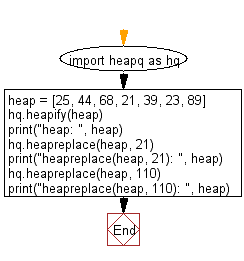Python: Delete the smallest element from the given Heap and then inserts a new item
Python heap queue algorithm: Exercise-5 with Solution
Write a Python program to delete the smallest element from the given Heap and then inserts a new item.
Sample Solution:
Python Code:
import heapq as hq
heap = [25, 44, 68, 21, 39, 23, 89]
hq.heapify(heap)
print("heap: ", heap)
hq.heapreplace(heap, 21)
print("heapreplace(heap, 21): ", heap)
hq.heapreplace(heap, 110)
print("heapreplace(heap, 110): ", heap)
Sample Output:
heap: [21, 25, 23, 44, 39, 68, 89] heapreplace(heap, 21): [21, 25, 23, 44, 39, 68, 89] heapreplace(heap, 110): [23, 25, 68, 44, 39, 110, 89]
Flowchart:

Visualize Python code execution:
The following tool visualize what the computer is doing step-by-step as it executes the said program:
Python Code Editor:
Have another way to solve this solution? Contribute your code (and comments) through Disqus.
Previous: Write a Python function which accepts an arbitrary list and converts it to a heap using Heap queue algorithm.
Next: Write a Python program to sort a given list of elements in ascending order using Heap queue algorithm.
What is the difficulty level of this exercise?
Test your Python skills with w3resource's quiz
Python: Tips of the Day
Creates a dictionary with the same keys as the provided dictionary and values generated by running the provided function for each value:
Example:
def tips_map_values(obj, fn):
ret = {}
for key in obj.keys():
ret[key] = fn(obj[key])
return ret
users = {
'Owen': { 'user': 'Owen', 'age': 29 },
'Eddie': { 'user': 'Eddie', 'age': 15 }
}
print(tips_map_values(users, lambda u : u['age'])) # {'Owen': 29, 'Eddie': 15}
Output:
{'Owen': 29, 'Eddie': 15}
- New Content published on w3resource:
- Scala Programming Exercises, Practice, Solution
- Python Itertools exercises
- Python Numpy exercises
- Python GeoPy Package exercises
- Python Pandas exercises
- Python nltk exercises
- Python BeautifulSoup exercises
- Form Template
- Composer - PHP Package Manager
- PHPUnit - PHP Testing
- Laravel - PHP Framework
- Angular - JavaScript Framework
- React - JavaScript Library
- Vue - JavaScript Framework
- Jest - JavaScript Testing Framework
